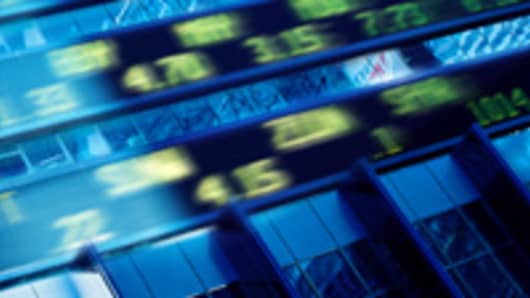Nanex, which was founded by Eric Hunsader, analyzed trading traffic before and after the capacity of the consolidated quote system (CQS) was increased. The CQS is the industry-supported electronic system by which quotes from the U.S. stock exchanges are disseminated.
On July 5th, the capacity for this system was increased by 33 percent to one million quotes per second and, by no coincidence, the trading activity rate reached that limit that very day, Hunsader’s firm said in the report.
"If three years ago someone told us that equity quote traffic rates for NYSE, AMEX and ARCA issues would exceed one million/second (not even counting Nasdaq stocks), we would have thought the market would have entered the greatest bull or bear market ever known,” the report states. "Instead, you can’t even recognize from a one-minute chart where these bursts of out-of-control quote traffic rates occur. And when they do occur, a significant percentage of those quotes will have already expired before they even leave the exchange network."
Sal Arnuk of Themis Trading believes he knows where those trades are coming from: The secretive high-speed hedge funds that pay the exchanges well for the privilege of having direct feeds into the exchange through trading hubs like the one for the NYSE in Mahwah, N.J.
"Firms know that if they send enough quotes, it slows down the tape," said Arnuk. The firms can then fill a retail order based on the slower public quote, while it simultaneously trades on information it gathers essentially milliseconds into the future through its faster direct feeds, said the market infrastructure expert who advised the SEC after last year’s infamous "flash crash."
"It’s possible that this is a form of latency arbitrageand the SEC needs to look into this," said Arnuk.
But traders wonder whether the SEC or CFTC is up to the task. The regulators’ official October report on the 15-minute plummet in the Dow Jones Industrial Average on May 6, 2011, blamed a liquidity crisis that followed a bad trade in S&P 500 futures. Officials have since taken action to prevent a similar catastrophe by instituting circuit breakers that halt individual stocks in the S&P 500 after a 10 percent move.
"At these rates of growth, we will no longer have a diversity of trading participants with accurate market data, and regulators will have no hope of ever piecing together what happened after the next disaster," stated the Nanex report. "It took the SEC five months just to assemble equity data to analyze the flash crash. When the next disaster strikes, they will have to contend with 5 to 10 times more data."
Program trading accounts for as much as 70 percent of the market volume on a daily basis, according to several traders’ and analysts’ estimates. Not all of this is nefarious, however. Even the practice of sending out multiple quotes in milliseconds and canceling them shortly thereafter is not necessarily cheating. Often these orders have to be canceled by a firm because they were filled on another exchange first.
"While virtually all institutions employ electronic trading for execution, very few use it strictly for alpha generation, so it is up to these firms to lead the lobbying effort to stop this practice," said Stephen Weiss of Short Hills Capital. "These issues will be handled by the regulators since this type of trading is employed for only a few at the risk of many."
Click here to see the full report entitled “Equity Quote Saturation” from Nanex.
For the best market insight, catch 'Fast Money' each night at 5pm ET, and the ‘Halftime Report’ each afternoon at 12:30 ET on CNBC.
______________________________________________________
Got something to say? Send us an e-mail at fastmoney-web@cnbc.com and your comment might be posted on the Rapid Recap! If you'd prefer to make a comment, but not have it published on our Web site, send your message to fastmoney@cnbc.com.
Trader disclosure: On July 7, 2011, the following stocks and commodities mentioned or intended to be mentioned on CNBC’s "Fast Money" were owned by the "Fast Money" traders;
Weiss owns (AKAM); Weiss owns (COP); Weiss owns (HBAN); Weiss owns (CMA); Weiss owns (KEY); Weiss owns (JPM); Weiss owns (TEVA); Weiss owns (QCOM); Weiss owns (VZ); Weiss owns (WFT); Weiss owns (PZN); Weiss owns (DE); Weiss owns (EMC); Weiss owns (ETP); Weiss owns (NS); Weiss owns (MDRX); Weiss owns (MSFT)



